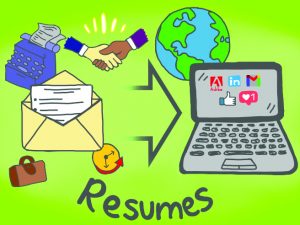Technology has changed the resume
April 21, 2021
Everyone is faced with confining their life’s education and experiences to one or two pages by writing a resume to use on jobs they are applying for.

With changes to technology, the process of filling out a resume has also changed drastically, opening up many opportunities for both applicants and employers.
In the conference paper titled “The Basic Principles of Resume Writing,” author Anna Kozlovska said, a valid resume that would get you an interview is “an advertisement of your skills, experience, and knowledge, presented in their most favorable light.”
The word resume is French, meaning “summary.” Leonardo da Vinci was the first recorded person to use an official resume in 1482. In his resume, he “wrote a letter to the Duke of Milan in an attempt to gain his patronage and support,” according to Davron LLC.
Records show the next leap in resumes was with an English land surveyor named Ralph Agas in the 1500s, who wrote advertisements where he described his skills and experience. He wrote this at a time where resume was not a common word, and therefore it was considered an advertisement.
After this millennium, there was no significant data on resumes until the 20th century. In 1930 the popularity of resumes surged, and by 1950, they were a prerequisite for getting an interview. The ‘80s brought a vast amount of change to the world of job applications.
According to Undercover Recruiter, in 1980, the first VHS resumes were recorded and used, in 1983, Microsoft Word launched and in 1987, fax machines became the most popular way to send resumes.
From the mid ‘90s and on, email took over, Adobe reader was released, LinkedIn launched, video resumes started and social media picked up.
Even though LinkedIn was launched in 2003, I have only recently seen it become popular. Many of my professors have encouraged students to start building profiles, making professional connections and maintaining a professional brand.
When looking into the last couple decades or so of resume writing, I thought “who better to ask about resumes than my parents?”
My mom told me she had a typewriter in college at UW Oshkosh in the late ‘80s, but she also was able to use a computer lab.
“It was mostly watching the newspaper for job postings and then driving to the place to fill out an application,” she said.
Either after using the typewriter or computer, she would then print her resume and cover letter on nice resume paper and mail in an envelope of the same material.
As proof of how much resumes have changed between my parents generation and mine, I had no clue of what resume paper was. According to Zesty Resume Help, resume paper is a type of paper “designed specifically for printing resumes and cover letters. For ideal quality, you should pick a paper with weight around 32 lb. and 75–100% cotton content.”
Then talking to my dad, who also went to UWO, he explained the process of filling out job applications by hand for applying to be a teacher after he earned his degrees.
“Teaching applications were a minimum of four pages front and back,” he said. “I had to include contact information, education from high school and up, multiple essays, and send a separate letter to UWO to request references, and finally submit an official set of transcripts too.”
He also had to keep an organized portfolio of lessons, coaching experiences, photos and some art skills which was a lot of work.
Today, filling out an application still has a lot of similar attributes and requires a similar amount of time and effort. But, with computers today, all one has to do is type out an application and attach it as a PDF in an email or through Handshake, which is used by 14 million college level students.
Instead of employers having to look over hand-written resumes and applications, technology algorithms and artificial intelligence use available data on resumes to find the best candidates for positions.
According to a LinkedIn survey from 2015, younger generations, especially millennials, are more likely to change jobs than older generations. This agrees well with my last article I wrote titled “It’s time to name the COVID-19 generation,” when referring to older generations being more settled down in life compared to millennials who are often looking for career advancement while “job-hopping.”
As drastic as resumes and job applications have changed, people now have extraordinary opportunities to build themselves a brand and connect more easily with employers online, which was not imaginable millennia ago.













